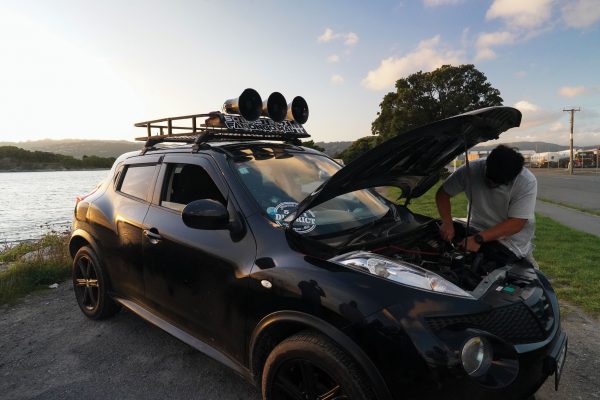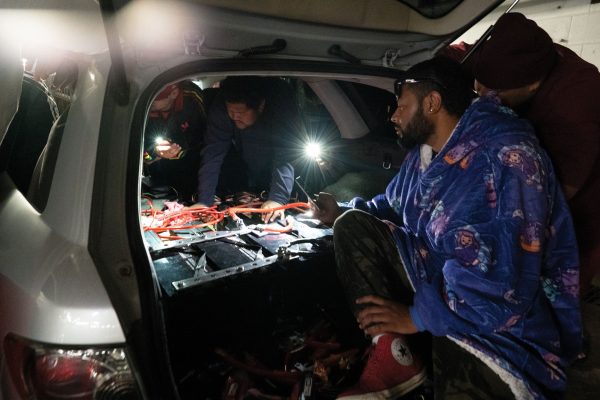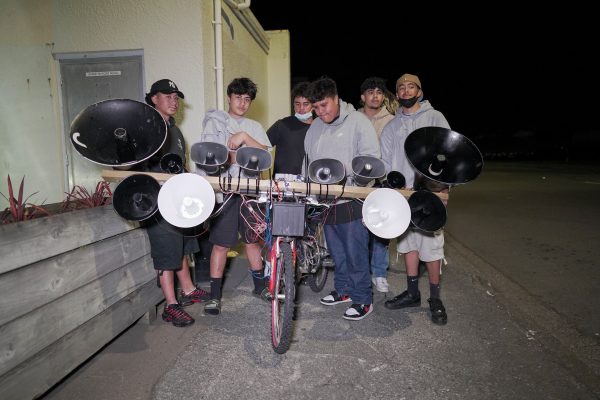
Loud and clear
Siren crews offer belonging and creativity as much as resounding treble or volume—all of which were on display at New Zealand’s first-ever national siren battle.
On wide, empty streets in the industrial part of Petone, a crew of teenagers surround Tai-Rhys Teao Allen, who is wheeling a bicycle top-heavy with sirens—so many sirens that it’s difficult for him to ride the bike without tipping to one side. Twelve sirens are arranged symmetrically along a wooden plank strapped to the front handlebars; two large black ones bookend the rest. A mass of brightly coloured wires connect the sirens to a car battery. I ask Tai-Rhys how old he is, and he says, “Fifteen,” and the others laugh and chime in and contradict him. He’s 13.
In a nearby parking lot, people dressed in hoodies and jeans and pristine white Nike or New Balance sneakers are standing around a glossy black car with an array of sirens. It’s their last chance to test the car that will be competing a few streets away. When one of the sirens blasts, the sound reverberates through the empty lot. A flock of birds rises above a concrete warehouse. The air is crisp and cool.
Tonight is the first-ever national siren battle, and the Wellington chapter of the Switch Hittaz is going up against the founding Auckland branch. Some local Lower Hutt crews are joining in as well. The victor will be the one with the loudest or clearest sound. And failing that, they’ll be the one who drowns out everyone else.
[Chapter Break]
On Toop Street, Lower Hutt, outside the Jets Transport freight depot, cars are drawn up facing the middle of the road. There are people movers decked out with sirens, and an Astro van, and slick, black BMWs, many of them sporting decals identifying their crews or memorialising family or crew members who have passed. The crews often wear hoodies with matching logos: the Switch Hittaz, District 5011, L.A.P.S. One car sports the stencilled hashtag #blacklinesmatter.
The crowd gradually swells to a couple of hundred people. It’s a party atmosphere. Some people drink from beer bottles, and the sweet, chemical smell of vaping fills the air. A ute is parked backwards so several girls in their early 20s can stand on the tray for a good view. One of them gives me a quick run-down about siren battles: they started in Tonga, on bikes. She’s heard the cops in Wellington are cool about them, and anyway, people could be out doing worse things than listening to sirens. She likes hearing the different tunes.

Siren culture arrived in Aotearoa in the early 2010s, and the Switch Hittaz crew started in west Auckland in 2015. Back then, four or five cars would get together to play their sirens. Now the crew involves more than 30 cars, plus chapters in Wellington and south Auckland.
“We didn’t think it would get this big,” says Sione*, who’s been with the west Auckland Switch Hittaz since the beginning. (He has kept the same siren stack on his van the whole time—two CSs, two Redback sirens, and two 30-watt Toas.)
Cars face off in pairs, in two rounds. The first round is to determine who has the clearer sound, and the second the louder. Competitors choose the music carefully: a song that’s high-pitched to showcase their sirens’ clarity and a song that works for volume. If it’s a tie, both cars play at once until one is drowned out.
Long-time Switch Hittaz member Suki Koau, better known as Papa Snow, tells me proudly that he is responsible for the fragments of Celine Dion that can be heard around west Auckland. He loves it. He has a warm chuckle and a friendly face, with flecks of white in his beard and hair. Papa Snow is part of a siren dynasty; his nephew Junior Tekauapi, aka Snow White, was one of the youngest to win the title of siren king. Usually, the title battle happens once a year, but it hasn’t happened since before the pandemic.

Papa Snow is surprised to hear that other people can find siren battles annoying—to him, it seems like an uplifting, harmless hobby. However, team leader Junior Afatia, who has lead the Switch Hittaz for three years, is more familiar with the range of public reactions. “A lot of people have negative things to say about it,” says Afatia. “But once you are in the siren scene it is completely different. It’s all about happy vibes, people dancing on cars, and meeting new people.”
I’m here with photographer Edith Amituanai, who has been following the Switch Hittaz for the past seven years. In 2019, she exhibited her pictures at Wellington’s Adam Art Gallery, a show which included a large-format image of Snow White preparing for the siren king battle. Lower Hutt crew L.A.P.S. brought some cars to the exhibition’s opening, a university student brought along a siren for ambiance, and Sione was there to represent the Auckland crew. It inspired the launch of the Wellington chapter of the Switch Hittaz, which got started about three years ago.
Amituanai says siren culture is uniquely Pasifika, and that’s what fascinates her about it. “Often [Pacific people] are participating in global phenomena,” she says. “When Pacific players play rugby, we just kill it—and we changed the game. But we didn’t make the game. We made sirens.”
[Chapter Break]
There’s no announcement when the battle starts, or of who is facing off against who. When one car wins—or appears to have won—people laugh and shout and begin dancing. Sometimes, spectators start celebrating too early, and then a judge waves people back, saying the cars need to go again before a winner can be determined. Each round is judged by someone from a non-competing team.
The sirens are the commercial kind used to emit warnings at factories or building sites or train stations, and so they aren’t designed to play music, just to emit high-pitched noises. The impact of their limited capacity is that some music distorts—but it also makes its own unique sounds.
The music that plays well through the sirens is music with a lot of treble, the sounds ranging from 6 kilohertz to 20 kilohertz—at the higher end of what’s audible. This accounts for the use of Celine Dion, whose high-pitched voice rings out with impressive clarity. In Wellington, says a local crew supporter known as Tune2Shake, old ladies sometimes come down and request Abba.
At times, the sound is clear and sonorous, at other times the sirens bleat with distortion. When it works well, the sound is intense, and bright—as if you are inside a glass dome or bubble. Outside of the bubble, the sound drops away. The speakers are so directional that a few metres away it is hard to tell which car is loudest.
Some of the cars have double stacks or triple stacks of sirens that sit high on their roofs. Sione explains to me that those stacks are built by guys who work as welders. Sirens cost between $100 and $200, and up to $400 for the really big ones, and the boys will usually do their wiring together, working on a couple of cars at a time. Sirens need to be wired to amps as well as switches on the head deck, with four to five sirens wired to a single amp. The crews wire sirens to separate switches, so that different sirens can play separately. Sometimes, they also wire LED lights to the sirens.


In the lead-up to a battle, they’ll be working every evening on the cars, then they’ll spend the night before the contest testing the sirens and tuning them. Being in a siren crew is a bit like being part of a sports team, from the intensive preparation for a competition to the Secret Santa at the Christmas barbecue. Like a family, the crew always have each other’s backs, and are loyal whether or not they’re active members. “There’s a saying we always say,” Junior Afatia tells me. “Once a Hittaz, always a Hittaz. Hittazups.”
Most of the night, I dance along and chuckle at the self-deprecating humour and teasing. I admire the clarity of Celine Dion, but I especially love the island music that transports me to the festivals and family events of my childhood. I notice a young woman with hair down to her knees dancing, insulated against the cold in a black puffer jacket. One young guy leans through the open window of the winning car and puts a cigarette in the lips of the winner. There’s a teenager laughing with her friends, wearing a Porirua Volleyball Club sweater.

I strike up a conversation with a woman keeping warm in a pink fluffy dressing gown. Siva Malaki is here supporting her son Tene Malaki from Wellington crew District 5011, which is the postcode for part of Lower Hutt. It’s Tene’s first official battle and many people from his church and family are here to support him, including his young daughter Maya, who’s wrapped in a teddy-bear dressing gown topped with little bear ears, and his sister, Susanna. Siren battles have an inclusive and welcoming atmosphere, Susanna tells me. “It’s a vibe,” she says. “A lot of people stereotype the sirens scene as just cars with annoying loud music but it’s more than that; it is a growing subculture for those who have a love of music, cars and sound.”
The only other bike competitor is a thin blond kid, Riley Tinney, also 13, from Taita College, who has three sirens across his handlebars. While Tai-Rhys is always surrounded by his crew, Riley is here by himself, mostly riding around in a large, slow circle, waiting for his round. Another teenager, who like Riley went to Taita College, tells me that kids from the school started the siren scene in Wellington. They used to take sirens from train stations, he says, but now they buy them.
[Chapter Break]
Siren battles have a complicated relationship with the law. When I attend a barbecue with the Switch Hittaz crew in an empty carpark in a west Auckland industrial area, a police officer stops by and tells everyone to leave. (No sirens are being played.) The officer then says the crew’s cars should have pink stickers on them, declaring them unroadworthy.
When I ask police about the legality of siren battles, spokespeople give me contradictory information. One says that all siren battles break the law, since sirens on cars are permitted only on emergency vehicles. Another says siren battles are legal but may be subject to local councils’ nuisance laws; people playing sirens on cars can be stopped “if they use them in a manner that creates disruption or a public perception that these vehicles belong to police or other emergency services”.

And yet, it’s hard to see how a parked car blasting ‘My Heart Will Go On’ could be mistaken for the police or emergency services. Amituanai says that in Auckland, the siren crews are increasingly on the receiving end of police action—being searched for firearms, or being ordered to remove their sirens.
In Wellington, the siren crews have a better relationship with the police. Joenah Iona, an organiser for the Wellington Switch Hittaz, tells me they have permission to play their sirens in this Lower Hutt industrial area, provided they finish at 10pm. The crew got special dispensation to continue later for the national battle.
Siren crews in Auckland have been asking for at least the past five years for a similar place to hold their battles. “If we could get a proper space to do our battles we’d love it,” one teenager told Stuff reporter Torika Tokelau in 2018. “It’s like playing football on the street, we don’t have a space of our own to do what we love.”
[Chapter Break]
It’s close to 1am, and the girl with knee-length hair is still dancing, but she’s ditched her puffer jacket, as though she’s immune to the chill wind. Burnouts have left a mess of swirly dark tyre thread marks on the road.
Justin Keresoma is competing on behalf of Team West, the sister crew of the west Auckland Switch Hittaz. First, he plays Celine Dion’s ‘Goodbye’s (The Saddest Word)’, then Jessica Mauboy’s ‘Fallin’’. For the drown-out round, he plays his own homemade edited song. He wins!


Junior Afatia is beaming with pride. “I’m really proud of the boys that helped on Justin’s car,” he says.
The two bikes have not competed yet, but the small blond kid, Riley, now has more sirens—five are wired to his bike instead of the three he started with. It strikes me that this is what siren culture is about: working together and making the most of what you have to hand, starting with your pride and your love of music, and expanding it out via portable sirens so that you are transmitting sounds that reverberate around the neighbourhood.
“It’s the joy of making something yourself,” says Amituanai. She says the crews might come home from their jobs at 7pm, having worked 12 hours, and then wire their cars until midnight.
“Your rent might be going up, it may feel unstable in your house. There’s something stable about putting your love into your car. The landlord can’t take that off you.”
The battle ends when the nine or so rounds have finished. There’ll be no single winner tonight—no siren king—but that isn’t the point. The point is for Wellington and Auckland crews to come together and share their love of sound, that common language, and see how far each crew has come. It’s to feel part of something bigger than yourself. It’s about hearing the results of those late-night wiring sessions, spending time together to make something new, turning humble speakers into mega sirens stacked high, and playing music that tells the world who you are.
*Name changed to protect privacy

















